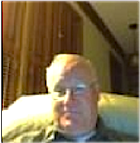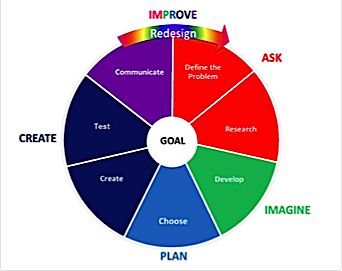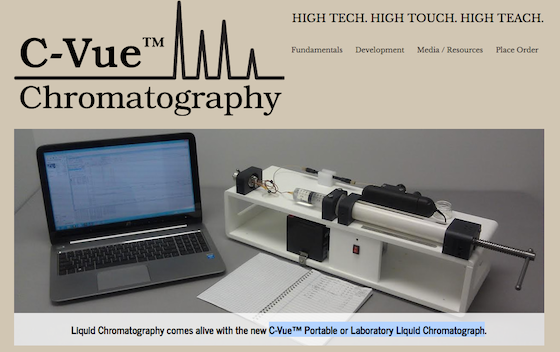Career Insights from a STEM Inventor

Terry’s latest accomplishment involves inventing C-Vue – a successful portable liquid chromatograph that’s affordable and can be used in classrooms. In short, it makes the magic of liquid chromatography available to kids at all levels. You can read about it here. This technology was one of three finalists for the 2013 InnoVision Awards (see the Southern Measurement Company in the Small Enterprise category).
The Terry Layne I recall from my classroom days definitely didn’t seem a candidate to become a serious inventor. He was a likeable, funny guy – one of those kids who had the knack of giving teachers fits while entertaining his classmates royally. But a budding successful inventor? Who would have guessed?
Terry Layne’s story
So I called Terry and asked him how he became an inventor. The account he told was so packed full of things we are trying to teach our students in STEM that I knew I had to write about it. Here, in a nutshell, is as much of Terry’s story as I can fit into this post:
“I remember in fourth grade making a conscious decision to pursue science. I had a deep curiosity about the physical universe–why was air a gas and water a liquid? Why did some rocks fracture on planes and others not? Why did coal burn but not other rocks? Science was fascinating because it provided answers that led to more questions.”
STEM principle: Terry’s STEM journey started decades before we joined those four letters together. He began by identifying questions and problems for which he wanted and needed answers. Sound familiar? That’s the first step of the engineering design process. During our conversation, Terry said that one of the most important things he learned to do was to ask the right kinds of questions – the kind that would lead you to the right answers.
“Academically, I was weak but refused to allow ADD or ADHD, or whatever term de jour, to prevent me from pursuing my favored career. If there is a takeaway from this, it must be for teachers to take note when kids are passionate about an area—even one that seems to be beyond their apparent academic capabilities. Curiosity and drive can overcome large obstacles.”
STEM principle: Curiosity – the kind of inquisitive thinking that leads to exploring and investigating is another goal of STEM lessons. Lessons should be designed to evoke and nurture curiosity in kids, and to develop a thirst for knowledge that drives learning.

Terry Layne today
“I also had a desire to do something that would have a positive impact on others. Dr. McCarn, the medical doctor in our small town, was my role model. Dr. McCarn, Mr. Florence the druggist, and my teachers were our only college educated role models. I grew up around coal mines. Maybe field trips that involved shadowing different types of businesses would have exposed me to some careers. As it was, I saw in most people of our community examples of where the lack of education led, and I did not want to go there. I was absolutely certain that the best pathway to a meaningful life was through education.”
STEM principle: Good STEM programs provide kids with access and exposure to broader career opportunities than traditional methods of presenting science and math content. And with its integrated focus on engineering, science, and mathematics, STEM continues this exposure across grade levels.
“My most memorable moment occurred in 7th grade. Mr. Biloon, the band director, had gotten me through whole notes, half notes, quarter notes and eighth notes…up and down the Bb scale…and then he assigned me to play each note in triplets. I just could not grasp the asymmetry of dividing each beat by three. Mr. Biloon saw my tears forming, patted me on the shoulder, and said, ‘You can’t play triplets …YET!! If you work hard enough and refuse to stop until you get it, you’ll succeed.’ When I finally began to play them correctly, he treated me as if I had just won a Nobel prize.”
STEM principle: In STEM classes, kids learn that failure is to be expected and that it’s okay. Failing and trying again is the way new technologies and inventions are developed. In fact, failure is regarded as a necessary step on the journey to success. And positive teacher feedback is always in order.

STEM principle: Ouch! The entire STEM vision is designed to replace and circumvent that kind of teaching. Engaging teams of kids in identifying and solving real world problems – and turning them loose to develop different approaches to solving these problems – is the heart of the true STEM lesson. The whole engineering process revolves around multiple approaches, multiple trials, and multiple redesigns.
Design principles at work
Take a look at the progression of Terry’s original design (the breadboard stage) to the prototype stage and to the final stage. At each step of the way Terry tried different approaches, experienced failures, and redesigned until he’d solved the problem of creating an inexpensive and highly efficient liquid chromatograph. Then he worked with someone to give it more cosmetic appeal. These are the stages our students go through in solving STEM problems. (Here are three stages of Terry’s invention, including the final one.)
Terry’s journey into the STEM world occurred through trial and error. Although he became an analytical chemist, he had no formal instruction and training in the STEM process. He was able to succeed, over time, in mastering the skills he needed to create and be a viable part of our 21st century workforce. How many students today will never get there? Terry had some final words of insight into that issue as well.
“When I go to a university, 80% of the professors teaching the sciences and mathematics are from other countries. Where are the professors from our country?”
STEM principle: With that statement, Terry identified the stated reason for incorporating STEM into our curriculum across the United States. We must prepare our students today to be a viable part of the nation’s 21st century workforce, and we can’t just wait and hope they acquire that knowledge over years through trial and error.
You’d like Terry. He’s still likeable and fun to be around. And to Terry – thanks, my inventor friend, for sharing your story with us.





































Great article Anne! Wonderful way of looking at learning!
Thanks! There’s no better way to learn than from another learner.
I like the phrase, “I wanted a chance to think…”
That phrase kinda says it all, doesn’t it? If nothing else, it’s a telling statement about the kind of teaching kids were receiving back in the day . . . and the kind of teaching some are still receiving.